Smart Solar Market: Size, Share, Trends & Forecast (2024-2029)
The report covers a comprehensive analysis segmented by Device (Smart Solar Meters, Intelligrid, Radio Frequency Identification (RFID)), By Solution (Asset Management, Network Monitoring, Meter Data Management, Remote Metering, SCADA, Others), By Application (Residential, Commercial, Industrial), By Geography (North America, South America, Asia Pacific, Europe, the Middle East, Africa)
Smart Solar Market Snapshot
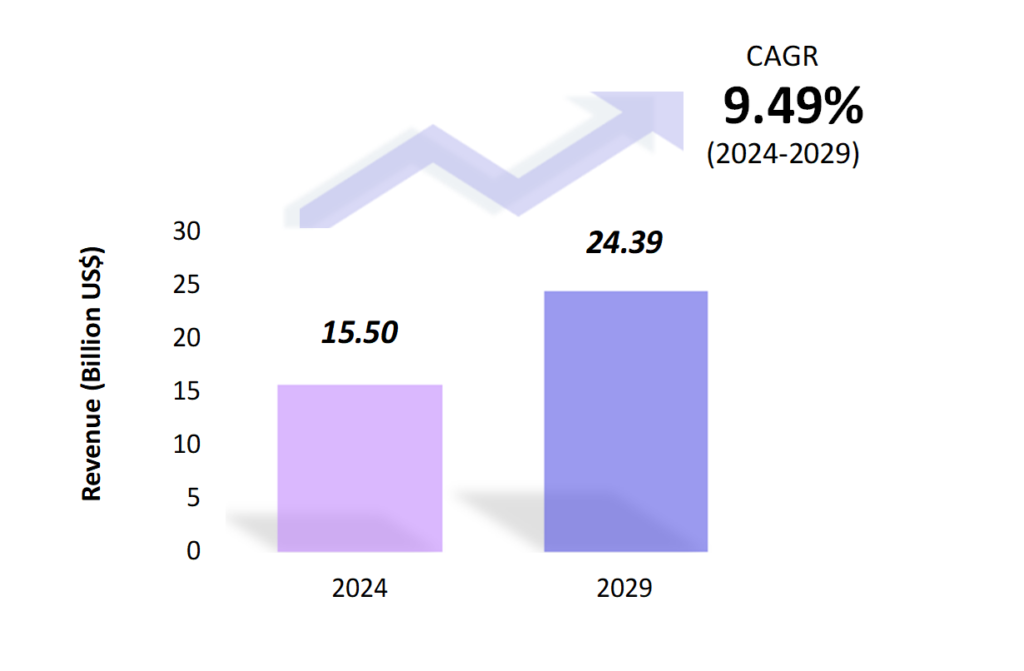
Smart Solar Market Overview
The global smart solar market is estimated to be at $15.5 Bn in 2024 and is anticipated to reach $24.39 Bn in 2029. The global smart solar market is registering a CAGR of 9.49% during the forecast period 2024-2029. Smart solar systems are an improved version of conventional solar energy systems. By using real-time communication and monitoring, smart solar systems help consumers save money on electricity while maximizing the performance of solar components. In the private sector, solar photovoltaics is the predominant renewable technology of choice. For example, according to the International Energy Agency (IEA), maintaining a generation growth rate consistent with the Net Zero scenario will necessitate annual solar capacity additions that are three times larger than those of 2022 until 2030.
Decision-makers encourage the advancement of intelligent inverter technologies to enable grid integration and lower balance-of-system costs. The European Union is accelerating the installation of solar PV in response to the energy crisis, adding 38 GW in 2022—a 50% increase from 2021. It is expected that the new goals and objectives of the REPowerEU Plan and the Green Deal Industrial Plan would serve as major accelerators for solar PV investment in the future years.
Increasing PV shares necessitate creative ways to control solar PV system generation and feed power into the grid, particularly in distribution systems. The goal of public R&D financing should be to reduce the overall balance-of-system costs associated with inverters and increase their efficiency. Inverters may account for 40–60% of all investment costs in a photovoltaic installation, depending on the region, according to IEA. As a result, it is expected that the need for sustainable energy solutions, environmental consciousness, and technology improvements will propel the smart solar market over the forecast period.
Smart Solar Market Coverage
| Historical & Forecast Period | 2018-2029 |
| Base Year | 2023 |
| Forecast Period | 2024-2029 |
| Units | Billion US$ |
| Segments | Device, Solution, Application |
| Geographies | North America, South America, Asia Pacific, Europe, The Middle East, Africa |
| Key Vendors |
ABB Group, Huawei Technologies Co., Ltd., Itron, Inc., Solnet Group, General Electric Co. |
Key Geographies of Smart Solar Market, 2023
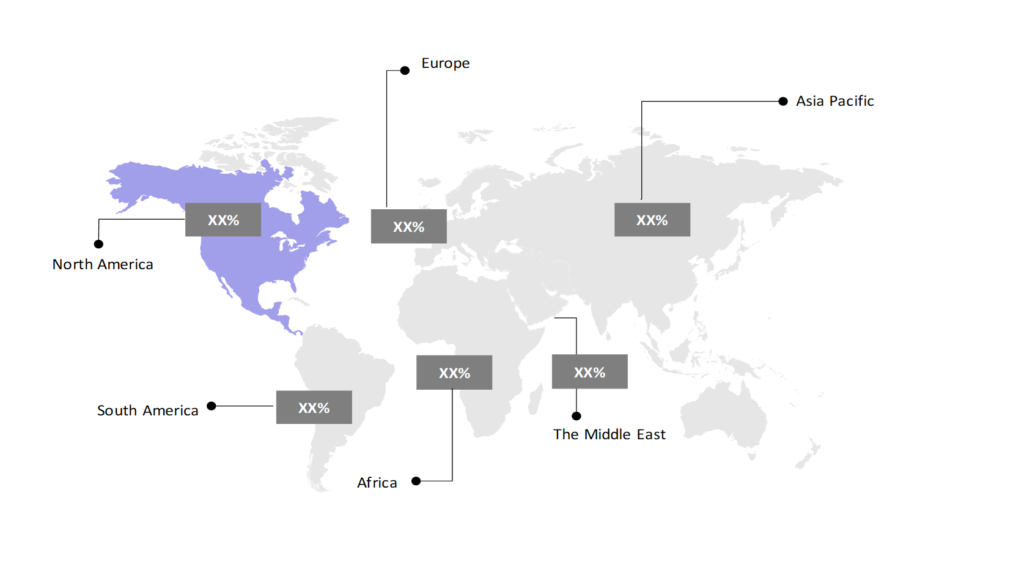
Porter’s 5 Forces Analysis of Smart Solar Market
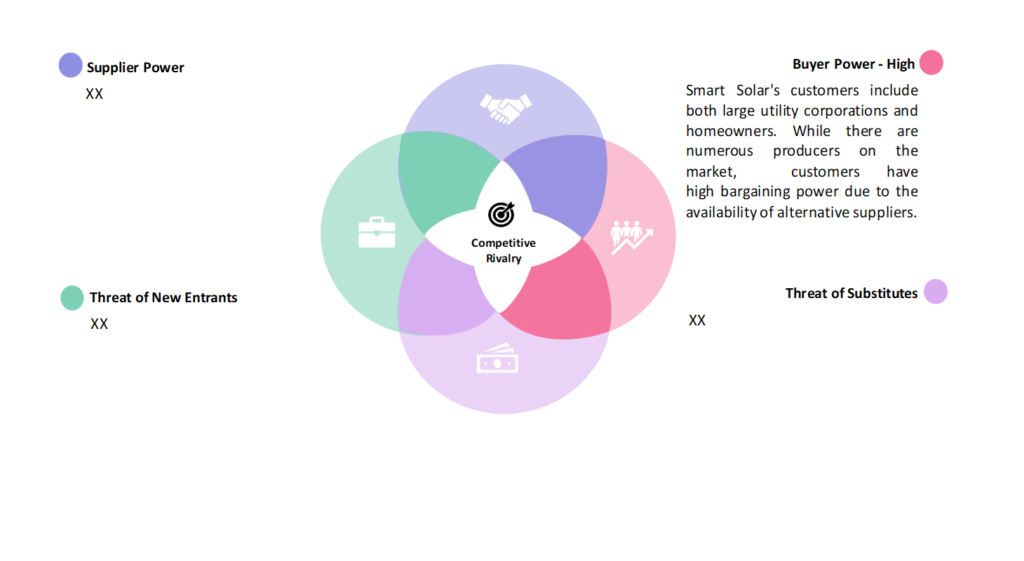
Smart Solar Market Trends
The idea of smart cities is becoming more popular, and developing sustainable urban environments requires solar energy. The more intelligent cities develop, the bigger the market is expected to be for smart solar systems. About 20 years ago, the idea of sustainable cities was initially put forth. Since then, it has influenced city administrators and contributed to the creation of sustainable cities. According to UN-Habitat, cities produce more than 60% of greenhouse gas emissions and consume 78% of the world’s energy. More than half of the world’s population lives in cities. By 2050, it will be seven out of ten. AI, machine learning algorithms, and IoT technologies are being integrated into the smart solar technology market. These advancements increase the effectiveness and efficiency of solar energy systems.
As smart grids become more sophisticated, smart solar systems play a crucial role in facilitating two-way communication between energy providers and consumers. This integration eventually increases the overall reliability and efficiency of the energy infrastructure by simplifying demand response, load balancing, and grid optimization. In the smart solar market, remote monitoring and predictive maintenance solutions are becoming increasingly popular. With these technologies, solar system performance can be remotely monitored, issues can be detected in real time, and preventive maintenance can be scheduled, all of which can reduce operating costs and downtime.
Smart Solar Market Driving Factors
The market for smart solar is being driven by decreasing solar photovoltaic (PV) costs and increasing expenditures in smart energy. Solar photovoltaic (PV) system costs have been declining steadily. This reduction, combined with technological developments, makes smart solar solutions more affordable and appealing to consumers. Smart solar system adoption is aided by government incentives and legislation. Market expansion is fueled by incentives such as tax credits, net metering, subsidies, and renewable energy goals, which all encourage investment in solar power infrastructure.
Governments worldwide are looking for cost-effective solutions. They are encouraging the public by providing subsidies and transitioning to green solutions, hence increasing the usage of smart solar solutions. For example, the Ministry of New and Renewable Energy (MNRE) implemented several regulatory initiatives to help India meet its solar goals by 2030. More than twice as much solar PV capacity was constructed in Brazil in 2022 as it was in 2021, according to the IEA. Given the continued demand for renewable energy from industry and power retailers, deployment is expected to remain at this level in the medium and long term. Furthermore, under its climate pledge, China intends to have 1,200 GW of solar and wind power capacity by 2030. These advancements quicken the market’s expansion.
Smart Solar Market Challenges
It can be challenging to retrofit older solar installations with smart technologies because of compatibility issues and the need for new hardware and software integration. To get the most out of smart solar solutions, they must be seamlessly integrated with legacy systems such as inverters and monitoring equipment. Smart solar systems create massive volumes of data from sensors, meters, and communication devices. Sophisticated analytics skills, skilled personnel, and a robust data management infrastructure are essential for efficiently handling, processing, and evaluating this data. Maintaining customer trust and regulatory compliance also depends heavily on data integrity, security, and privacy.
Furthermore, the deployment and management of smart solar systems require specific expertise in data analytics, information technology, and renewable energy. To establish a trained workforce that can serve the expanding smart solar business, it is imperative to address the skills gap through industry-academia cooperation, workforce development efforts, and training programs.
Smart Solar Market – Key Industry News
- In September 2023, Renogy, a developer of renewable solar energy solutions, introduced REGO, the first fully integrated smart solar power system for off-grid homes. The REGO Series solutions save clients time and stress since they are a true plug-and-play power system with flawless component operation. They are made especially for beginners, do-it-yourselfers, and experienced solar energy users.
- In April 2023, scientists at Newcastle University produced environmentally friendly, highly efficient solar cells with a power conversion efficiency of 38% to power Internet of Things devices using ambient light. To maximize energy efficiency and reduce power losses, they also presented an energy management strategy based on LSTM neural networks.
- In January 2023, Lonestar Cell Mobile Telecommunications Network declared that intelligent solar-hybrid generators will be placed at key areas across the nation to decrease the environmental impact of burning fossil fuels and to meet Project Zero goals. Project Zero was launched by the company to lower carbon emissions and encourage business sustainability to stop climate change in Liberia.
Smart Solar Market Competitive Landscape
The participants in the global smart solar industry are always developing their strategies to preserve a competitive advantage. Companies primarily use acquisitions, R&D, partnerships, and technological launches. Several important entities in the smart solar market include ABB Group, Huawei Technologies Co., Ltd., Itron, Inc., Solnet Group, General Electric Co., and others.
Smart Solar Market Company Share Analysis, 2023 (%)
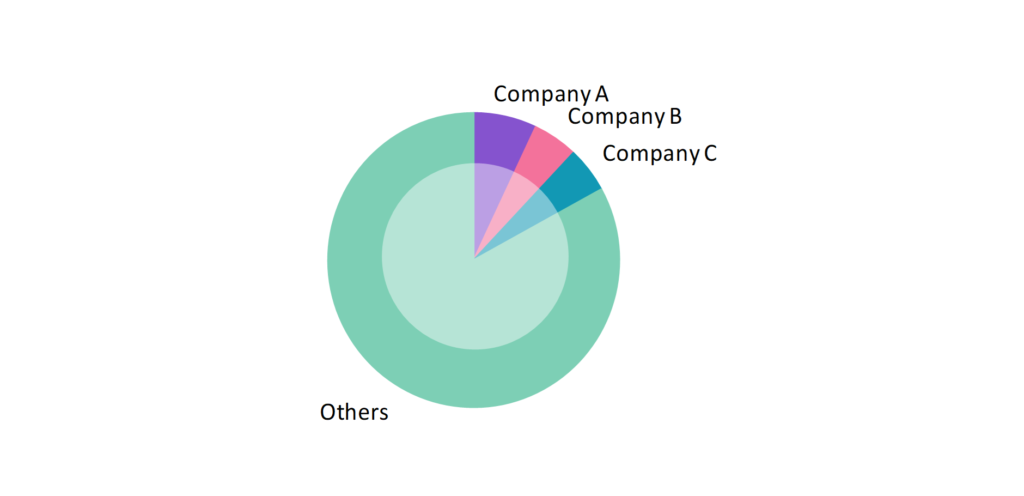
Smart Solar Market – Key Companies
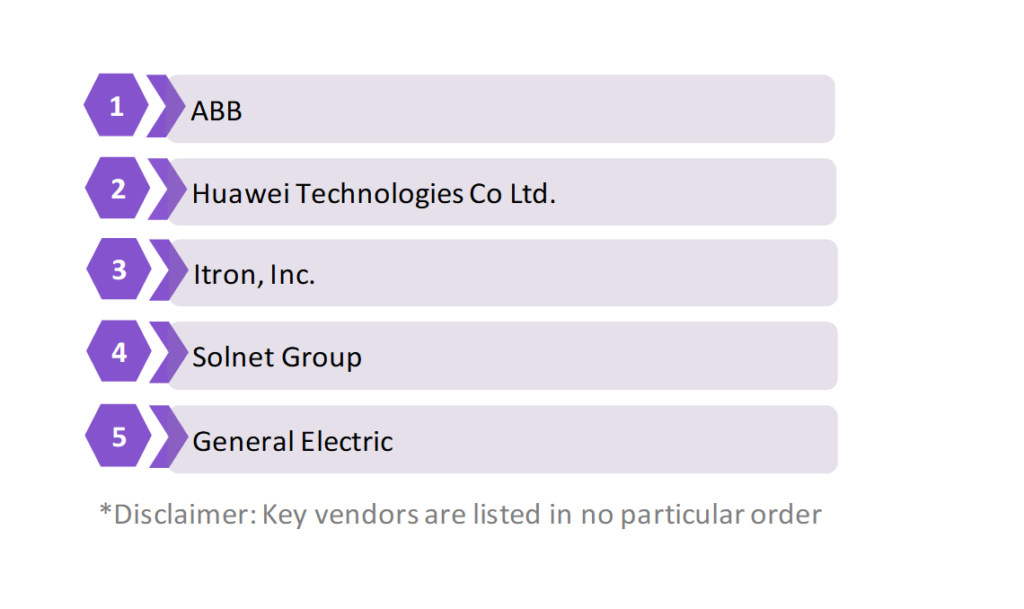
Reason to Buy from us

Table of Contents
| 1. Introduction |
|---|
| 1.1. Research Methodology |
| 1.2. Scope of the Study |
| 2. Market Overview / Executive Summary |
| 2.1. Global Smart Solar Market (2018 – 2022) |
| 2.2. Global Smart Solar Market (2023 – 2029) |
| 3. Market Segmentation |
| 3.1. Global Smart Solar Market by Device |
| 3.1.1. Smart Solar Meters |
| 3.1.2. Intelligrid |
| 3.1.3. Radio Frequency Identification (RFID) |
| 3.2. Global Smart Solar Market by Solution |
| 3.2.1. Asset Management |
| 3.2.2. Network Monitoring |
| 3.2.3. Meter Data Management |
| 3.2.4. Remote Metering |
| 3.2.5. SCADA |
| 3.2.6. Others |
| 3.3. Global Smart Solar Market by Application |
| 3.3.1. Residential |
| 3.3.2. Commercial |
| 3.3.3. Industrial |
| 4. Regional Segmentation |
| 4.1. North America |
| 4.1.1. The U.S. |
| 4.1.2. Canada |
| 4.1.3. Mexico |
| 4.2. South America |
| 4.2.1. Brazil |
| 4.2.2. Argentina |
| 4.2.3. Colombia |
| 4.2.4. Chile |
| 4.2.5. Rest of South America |
| 4.3. Asia Pacific |
| 4.3.1. China |
| 4.3.2. India |
| 4.3.3. Japan |
| 4.3.4. South Korea |
| 4.3.5. Rest of Asia Pacific |
| 4.4. Europe |
| 4.4.1. UK |
| 4.4.2. Germany |
| 4.4.3. Italy |
| 4.4.4. France |
| 4.4.5. Spain |
| 4.4.6. Rest of Europe |
| 4.5. The Middle East |
| 4.5.1. Turkey |
| 4.5.2. UAE |
| 4.5.3. Saudi Arabia |
| 4.5.4. Rest of the Middle East |
| 4.6. Africa |
| 4.6.1. Egypt |
| 4.6.2. South Africa |
| 4.6.3. Rest of Africa |
| 5. Value Chain Analysis of the Global Smart Solar Market |
| 6. Porter Five Forces Analysis |
| 6.1. Threats of New Entrants |
| 6.2. Threats of Substitutes |
| 6.3. Bargaining Power of Buyers |
| 6.4. Bargaining Power of Suppliers |
| 6.5. Competition in the Industry |
| 7. Trends, Drivers and Challenges Analysis |
| 7.1. Market Trends |
| 7.1.1. Market Trend 1 |
| 7.1.2. Market Trend 2 |
| 7.1.3. Market Trend 3 |
| 7.1.4. Market Trend 4 |
| 7.1.5. Market Trend 5 |
| 7.2. Market Drivers |
| 7.2.1. Market Driver 1 |
| 7.2.2. Market Driver 2 |
| 7.2.3. Market Driver 3 |
| 7.2.4. Market Driver 4 |
| 7.2.5. Market Driver 5 |
| 7.3. Market Challenges |
| 7.3.1. Market Challenge 1 |
| 7.3.2. Market Challenge 2 |
| 7.3.3. Market Challenge 3 |
| 7.3.4. Market Challenge 4 |
| 7.3.5. Market Challenge 5 |
| 8. Regulatory Landscape |
| 9. Competitive Landscape |
| 9.1. ABB Group |
| 9.2. Huawei Technologies Co., Ltd. |
| 9.3. Itron, Inc. |
| 9.4. Solnet Group |
| 9.5. General Electric Co. |
| 9.6. Company 6 |
| 9.7. Company 7 |
| 9.8. Company 8 |
| 9.9. Company 9 |
| 9.10. Company 10 |
Smart Solar Market – Frequently Asked Questions (FAQs)
What is the current size of the global smart solar market?
The market size for the global smart solar market in 2024 is $15.5 Bn.
Who are the major vendors in the global smart solar market?
The major vendors in the global smart solar market are ABB Group, Huawei Technologies Co., Ltd., Itron, Inc., Solnet Group, and General Electric Co.
Which segments are covered under the global smart solar market segments analysis?
This report offers in-depth insights into each device, solution, application.
